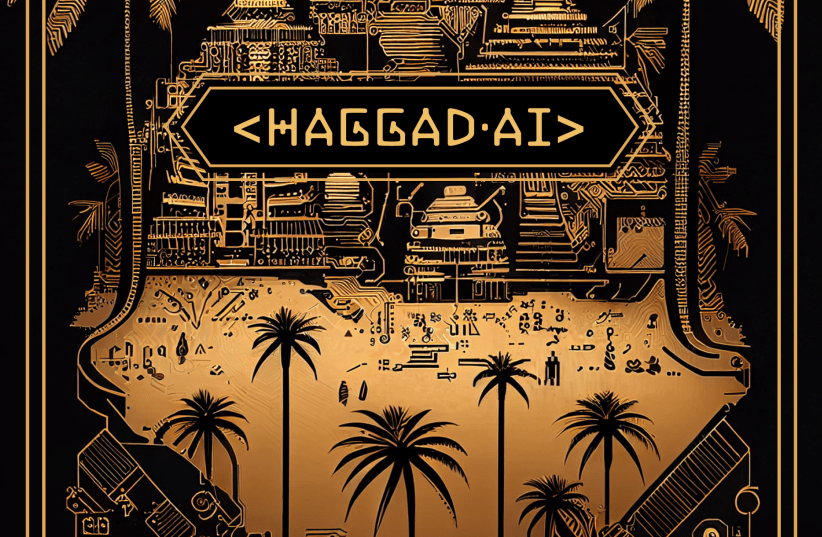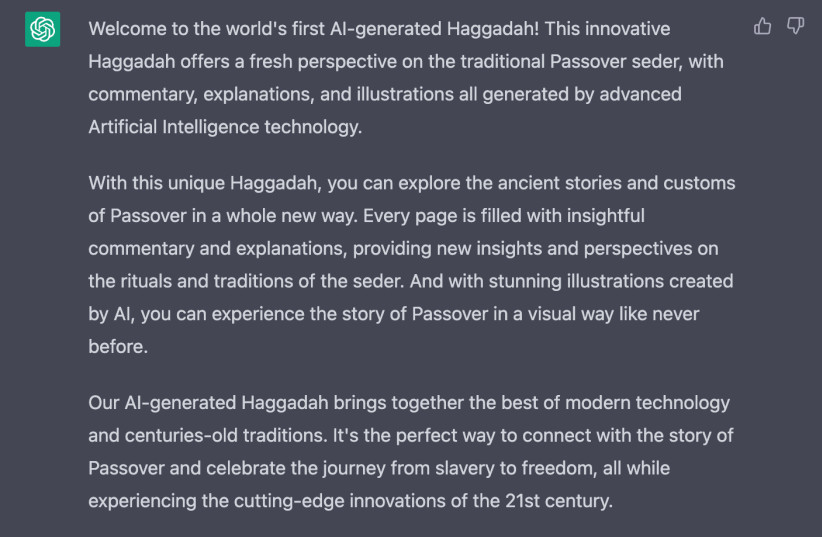Every few years, a new digital phenomenon stuns the world and is then immediately implemented into Jewish life. This year, it is all about artificial intelligence (AI) and the automatic creation of texts and images.
Now, two Israeli artists have created the world’s first Passover Haggadah with commentary and artwork – all created by AI generators. The new Haggadah has images of the Four Sons; most look like daughters, and the ancient Hebrews are portrayed as African slaves.
Meet Haggad.AI, a project created by graphic designer and photographer Yitzchak Woolf and Jerusalem architect Royi Shamir.
Woolf was born in Toronto and immigrated to Israel 17 years ago. As the co-owner of Let’s Bench, a company that specializes in creating unique and personalized Jewish religious items, he has extensive experience in creating products that connect people to their faith and heritage.
Shamir received both his bachelor’s and master’s degrees in architecture from the Technion-Israel Institute of Technology, where he wrote his master’s thesis about the “haredification” of secular neighborhoods in Jerusalem and the mechanisms that, according to Halacha, are being used in that process.
“A few months ago, we were sitting and playing with ChatGPT and Midjourney and thought about how it could be relevant to the Jewish world and what the implications were,” Woolf told The Jerusalem Post. “We both have an interest in the connection between Jewish text and design, and we thought the Haggadah could be a great AI playground.”
“Combining both textual and visual elements, the Haggadah has served as a pinnacle platform for Jewish design and art, which makes it a perfect fit for language-based and image-based AI models,” he said.
Woolf said he and Shamir thought the application of AI technology to the central text of the Passover Seder “would unlock new insights and perspectives,” illuminating the “intricacies of both the Haggadah itself and the broader traditions it represents.”
Shamir said he and Woolf were sure this would be an easy project since all of the work is done by AI, but they were wrong.
“We figured that if we gave it simple, obvious prompts, the AI engines would provide exactly what we were looking for,” he told the Post. “For the Torah portions, ChatGPT was relatively instantaneous, though the graphic part of the creation turned out to be a lot more difficult.”
Woolf said: “[With] Midjourney, our AI image creator, [it] was extremely difficult to create the images that we wanted. Rarely, we would feed it a prompt and get a great image within three or four tries. But for the most part, we had to spend several hours, days or weeks trying to push Midjourney to create an image that would be great.”
According to Shamir, “The afikoman [matzah that is hidden for children to find at the end of the Seder] was the hardest to find. It kept on creating images of matzah that looked like pizza or focaccia. We spent a few weeks searching for the afikoman.”
Asked how they created commentary using AI while avoiding mistakes made by the computer, Shamir said they “didn’t try to avoid those mistakes,” but rather “tried to embrace them as much as we could.” For example, he said, “In some instances, it was clear the AI did not understand what it was talking about.”
Woolf said ChatGPT made mistakes with Hebrew letters that represent central parts of the Haggadah.
“Those kinds of obvious mistakes we chose not to include,” he said.
Shamir said there were other times when ChatGPT created its own stories that the two men were not familiar with.
“ChatGPT said that during their wandering time in the desert, they [the Israelites] were looking for a piece of matzah until a man named Tzafun came and revealed the location of the hidden matzah, the afikoman, which represented their connection to God,” he said, adding that this idea does not have any historical basis. “Although it is a completely original midrash [biblical interpretation], we thought we could still see some truth and beauty in it.”
To differentiate the AI-generated text from the traditional text of the Haggadah, they created the character of Rabb.AI, an AI rabbi who accompanies the Seder and gives commentary, which is set in a different color than the AI text.
They asked ChatGPT to write a disclaimer for Rabb.AI, and it responded: “It is important to note that my commentary is limited by its reliance on preexisting data and programming... Ultimately, readers should approach my commentary with an open mind and a critical eye, using their own judgment and consulting with authoritative sources, as it is written in Mishlei [Proverbs] 14:15, ‘The naive believes everything, but the prudent man looks where he is going.’”
According to Woolf, “This disclaimer is aligned with the very basic principle of the Seder, which is asking questions. We see this whole Haggadah as one big question being asked. Is this midrash true? We hope it will provoke interest, conversation and discussion around the Seder table.”
The prompts they used on ChatGPT were very generic, he said, “because we didn’t want to tell it what to write and wanted to be surprised by the results.”
However, they discovered that with Midjourney, their AI artist, the prompts had to be much more detailed, Woolf said.
“We decided early on that none of the artwork should be in the same style because we wanted to show the scope of what Midjourney has to offer and to demonstrate its abilities,” he said. “We also weren’t comfortable asking Midjourney to copy the style of any specific artist, so we asked it to create art in various styles and movements, such as Cubism, Medieval frescoes, cave painting, documentary photography, 1950s TV commercials, linocut, Ligne Claire, vintage Israeli poster design and more. In doing so, we were able to create more than 30 unique images.”
The images are beautifully placed throughout the Haggadah and can be surprising at times. For instance, the Hillel sandwich – two pieces of matzah, lettuce, haroset and a piece of meat (during the times of the Temple) is portrayed as a slick modern photo – as if it was taken in 2023 and placed in a cookbook, with beautiful composition, even though this type of sandwich is not eaten nowadays.
The Haggad.AI is available for purchase directly from www.haggad.ai for those residing in Israel. It is also available worldwide on Amazon.


